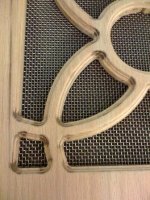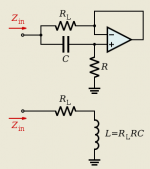carpenter said:I drove across town today and purchase some attractive stainless steel screen mesh for the amp vent ports. Here's what it looks like with the lid:
Nice find
Must of been tough finding the stainless screen.
Marine chanderly?
any links? PN?
TIN
infinia said:
Nice find
Must of been tough finding the stainless screen.
Marine chanderly?
any links? PN?
TIN
They're called: Western Wire Work, Inc. part of the Western Group/Oregon
Part disc: 6M047T30448 6MESH .047T304 48"
call: Kimberly Jones 503-455-0316
email: kimj--at--thewesterngroup.com
Boy, did I get an eye-opener this morning: my inductance meter isn't worth the powder to blow it to hell...
I mistakenly thought my Plitron secondary outputs had an inductance of 30mH. After speaking with Eric at Plitron, I discovered that they are actually rated at 700mH!
I did some scouring on the "net" and located interesting methods of measuring with a greater degree of accuracy. A great deal more power is involved.
So, this is simply a word-to-the-wise, don't trust a simple, handheld inductance meter's readings on a large choke. Also, this means an air core choke is going to be large, very large.
Amazing stuff...
I mistakenly thought my Plitron secondary outputs had an inductance of 30mH. After speaking with Eric at Plitron, I discovered that they are actually rated at 700mH!
I did some scouring on the "net" and located interesting methods of measuring with a greater degree of accuracy. A great deal more power is involved.
So, this is simply a word-to-the-wise, don't trust a simple, handheld inductance meter's readings on a large choke. Also, this means an air core choke is going to be large, very large.
Amazing stuff...
Now it all makes sense again 😀
And yes, air cores are big, I already had that figured Hence the thread title 😉
Hence the thread title 😉
Magura 🙂
And yes, air cores are big, I already had that figured
 Hence the thread title 😉
Hence the thread title 😉Magura 🙂
Hahahaaaa...
So, just how big is a bifilar wound 700mH choke? Equally important, what's the resistance? Resistance in a choke equals heat--especially with 20 amps, 10 amps per side.
I will most likely stick with an iron core to keep the resistance/heat at bay. Fortunately, with plenty of amperage, the sound is very smooth.
So, just how big is a bifilar wound 700mH choke? Equally important, what's the resistance? Resistance in a choke equals heat--especially with 20 amps, 10 amps per side.
I will most likely stick with an iron core to keep the resistance/heat at bay. Fortunately, with plenty of amperage, the sound is very smooth.
carpenter said:Hahahaaaa...
So, just how big is a bifilar wound 700mH choke? Equally important, what's the resistance? Resistance in a choke equals heat--especially with 20 amps, 10 amps per side.
I will most likely stick with an iron core to keep the resistance/heat at bay. Fortunately, with plenty of amperage, the sound is very smooth.
A wild guess would be something like 35kg, DCR around 12R to 15R.
Not so bad really.
Magura 🙂
carpenter said:I need the R to be around 0.25 ohms per leg...
......and now you're at it, why not demand the earth to be flat as well?

First and foremost, you don't need 700mH, but 2 x 80mH.
Now that we have gotten that out of the way, you can get down to a DCR of 2R per winding, and you're down to a mere 20kg inductor.
Magura 🙂
20 kg isn't that bad; my power transformer weighs around 17 kg as does the LC filter inductor. I'll have to see what 2 ohms does to my circuit...
carpenter said:weighs around 17 kg as does the LC filter inductor.
Why?
A 2mH inductor for a CLC does the trick. If you wanna go all over board, some 5mH.
That's less than 2kg for an air-core.
Magura 🙂
My LC gets the ripple down to 37mV--after which the differential follower amp gets it down to nothing my meter can measure...0.000 VAC
Your idea of using an air core inductor is great, but added resistance just cooks the living daylights out of them.
I just simmed inductors with 2ohm resistance. I have to increase my PS to 20 volts, vs 6 volts originally with a low impedance inductor. With 2 ohms resistance, there's 80 watts through each leg.
To improve the power curve appearance, I simmed in a 12v negative power supply and CCS. Now, we're talking over 200 watts per leg to get a nice looking power curve.
Your idea of using an air core inductor is great, but added resistance just cooks the living daylights out of them.
I just simmed inductors with 2ohm resistance. I have to increase my PS to 20 volts, vs 6 volts originally with a low impedance inductor. With 2 ohms resistance, there's 80 watts through each leg.
To improve the power curve appearance, I simmed in a 12v negative power supply and CCS. Now, we're talking over 200 watts per leg to get a nice looking power curve.
So, I connected one side of a hand-wound, bifilar, air-core choke to the PS. It's the L of the LC filter. The choke is probably close to what magura mentioned earlier, though not as closely coupled due to the unused bifilar winding and the individually taped coil layers. It has an R value of roughly 0.27 ohms. The unfiltered DC is nearly 11 volts under load. Filtered output is 6.4 volts DC. I'm losing about 4.5 volts to the choke.
The sims says the choke is absorbing 76 watts. Sad... but on the bright side, it depicts it as being a very stable current source. Simmed current fluctuation is next to nothing. 16.828898 amp to 16.828899 amp variance with the amplifier in operation. Of course, it's just a simulation, but it's nice to see these numbers--the sim generally gets me in the ballpark. I can't hear a difference in the sound between the air-core and the iron core LC filter--but I'll have my "golden ears" wife lend her voice to the matter when she's off work this evening. I do know that those 0.27 ohms are creating a great deal of inefficiency.
The sims says the choke is absorbing 76 watts. Sad... but on the bright side, it depicts it as being a very stable current source. Simmed current fluctuation is next to nothing. 16.828898 amp to 16.828899 amp variance with the amplifier in operation. Of course, it's just a simulation, but it's nice to see these numbers--the sim generally gets me in the ballpark. I can't hear a difference in the sound between the air-core and the iron core LC filter--but I'll have my "golden ears" wife lend her voice to the matter when she's off work this evening. I do know that those 0.27 ohms are creating a great deal of inefficiency.
jameshillj said:Might be worth a look at the "world of Gyrators", hmm?
Uhh, if the Wiki is correct, a gyrator uses and op amp, which is going to be too small for my amplifier. Do you have a link available for high current versions?
Attachments
There's a couple of active threads about Gyrators, but the easiest way would be to ask "Wavebourn" directly - He's pretty clued up about "all things Gyrator" and could advise you well.
How's that troublesome shoulder doing now? ZM has been having some very annoying back problems, too.
How's that troublesome shoulder doing now? ZM has been having some very annoying back problems, too.
Off Topic
Getting older is such a pain in the butt... shoulder is troublesome, but functional. I can barely do 20 modified (on my knees) push ups daily through the ache--heart and body's willing, shoulder's not. Legs work, so I can walk. I have a long, steep, circular driveway--keeps my heart in shape 20 minutes a day. Doing stomach crunches too.
Best of all, I'm smiling.
Got a new contracting business (LLC) started called "Intelligent Remodeling". I have a young partner, bright and willing to learn. I've even landed a few leads. Life is good.
Sorry to hear that Choky's back is bothering him. Really like that fellow.
How's life in your neck of the woods?
Getting older is such a pain in the butt... shoulder is troublesome, but functional. I can barely do 20 modified (on my knees) push ups daily through the ache--heart and body's willing, shoulder's not. Legs work, so I can walk. I have a long, steep, circular driveway--keeps my heart in shape 20 minutes a day. Doing stomach crunches too.
Best of all, I'm smiling.
Got a new contracting business (LLC) started called "Intelligent Remodeling". I have a young partner, bright and willing to learn. I've even landed a few leads. Life is good.
Sorry to hear that Choky's back is bothering him. Really like that fellow.
How's life in your neck of the woods?
'tis winter, 'tis colder, getting by, getting older! The "Tomatis Therapy" thing is still defeating the tinnitus, CPS, etc - thank goodness!
Economics aren't too bad here, but still have to tighten the belt a bit, and some project set back to next year.
Gyrators - looking very interesting.
I'm studying Sy's Acheron Xover (the valve Hi-pass) with his Heretical valve stages and remembered your work here - at the same time, got interested in the gyrator ccts (total novice!) as a possible combination for replacement of basic resistor/choke load, and/or a Hexfet CCS load.
I was wondering if it was possible to combine the more natural sound (IMO!) of the resistor/choke load with the better transients, speed of the CCS.
I think a similar thing applies to the jfet ccts, but could easily be imagining things.
I also need a good front end buffer for EUVL's DOA follower headamp and looking at A.Cavalli's OCL stage - same load question.
Incidently, suggest you get onto Salas' shunt regulator - 'tis a winner for ccts like we use. ["Salas low voltage shunt reg" Also a high volt design, too.]
Economics aren't too bad here, but still have to tighten the belt a bit, and some project set back to next year.
Gyrators - looking very interesting.
I'm studying Sy's Acheron Xover (the valve Hi-pass) with his Heretical valve stages and remembered your work here - at the same time, got interested in the gyrator ccts (total novice!) as a possible combination for replacement of basic resistor/choke load, and/or a Hexfet CCS load.
I was wondering if it was possible to combine the more natural sound (IMO!) of the resistor/choke load with the better transients, speed of the CCS.
I think a similar thing applies to the jfet ccts, but could easily be imagining things.
I also need a good front end buffer for EUVL's DOA follower headamp and looking at A.Cavalli's OCL stage - same load question.
Incidently, suggest you get onto Salas' shunt regulator - 'tis a winner for ccts like we use. ["Salas low voltage shunt reg" Also a high volt design, too.]
carpenter said:Uhh, if the Wiki is correct, a gyrator uses and op amp, which is going to be too small for my amplifier. Do you have a link available for high current versions?
If you want a power gyrator, you can consider using a single-ended
power Mosfet or complementary push-pull power Mosfets as followers,
with the Gate(s) being the + terminal corresponding to the op amp.
😎
- Status
- Not open for further replies.
- Home
- Amplifiers
- Pass Labs
- No more aching back

